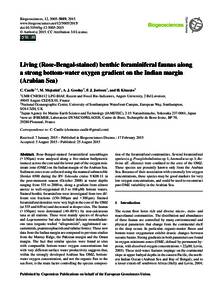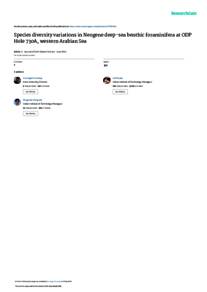Document
Living (Rose-Bengal-stained) benthic foraminiferal faunas along a strong bottom-water oxygen gradient on the Indian margin (Arabian Sea).
Identifier
DOI: 10.5194/bg-12-5005-2015
Contributors
Publisher
Copernicus GmbH.
Gregorian
2015-08
Language
English
Subject
English abstract
Rose-Bengal-stained foraminiferal assemblages (> 150 μm) were analysed along a five-station bathymetric transect across the core and the lower part of the oxygen minimum zone (OMZ) on the Indian margin of the Arabian Sea. Sediment cores were collected using the manned submersible Shinkai 6500 during the RV Yokosuka cruise YK08-11 in the post-monsoon season (October 2008) at water depths ranging from 535 to 2000 m, along a gradient from almost anoxic to well-oxygenated (0.3 to 108 μM) bottom waters. Stained benthic foraminifera were investigated from two different size fractions (150-300 μm and > 300 μm). Stained foraminiferal densities were very high in the core of the OMZ (at 535 and 649 m) and decreased at deeper sites. The faunas (> 150 μm) were dominated (40-80 %) by non-calcareous taxa at all stations. These were mainly species of Reophax and Lagenammina but also included delicate monothalamous taxa (organic-walled "allogromiids", agglutinated saccamminids, psammosphaerids and tubular forms). These new data from the Indian margin are compared to previous studies from the Murray Ridge, the Pakistan margin and the Oman margin. The fact that similar species were found at sites with comparable bottom-water oxygen concentrations but with very different surface water productivity suggests that, within the strongly developed Arabian Sea OMZ, bottom-water oxygen concentration, and not the organic flux to the sea floor, is the main factor controlling the species composition of the foraminiferal communities. Several foraminiferal species (e.g. Praeglobobulimina sp. 1, Ammodiscus sp. 1, Bolivina aff. dilatata) were confined to the core of the OMZ. These species are presently known only from the Arabian Sea. Because of their association with extremely low oxygen concentrations, these species may be good markers for very low oxygen concentrations, and could be used to reconstruct past OMZ variability in the Arabian Sea.
Member of
ISSN
1726-4170
Resource URL
Category
Journal articles


